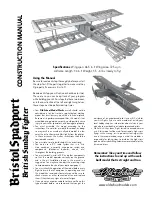
Construction Manual
www.oldschoolmodels.com
Page 15
British
Sunday Fighter
Bristol Spadport
N3 is glued between the front
edges of the fuselage sides as
shown in the photo. Make sure
N3 is aligned along it’s length.
Step 115 - Fuselage Assembly (N4)
Locate N4 from LP5. As it
is oversized, the sides will
need to be trimmed so it fits
as shown in the photo. flush
with the bottom edge of the
fuselage sides.
Glue this in place making N4
is aligned along the fuselage
sides.
When the glue has cured, cut away N3’s cross brace.
Step 116 - Fuselage Assembly (nose stringers)
Locate scrap 1/8” square balsa
strips to form the three stringers
as shown here.
Measure, cut and glue these in
position.
Step 117 - Fuselage Assembly (top nose sheeting)
Using 1/16” sheeting, now sheet
the top of the cowl area as shown
here.
Again do this in 3 pieces and use
Windex® to aid in bending the
balsa.
Step 118 - Fuselage Assembly (bottom nose sheeting)
This is another optional step.
We chose to cover this area
with our electric prototypes,
but not in our glow powered
versions.
If you choose to sheet the
bottom of the cowl, use scrap
3/32” balsa sheet, cross-
grained.
Step 119 - Fuselage Assembly (N1 & N2)
Locate both N1’s and both N2’s
from BP7. These will be glued to
the nose to give you a finished
surface that can be easily sanded
and rounded for a better look.
Glue one N1 to the front of
fuselage, then trim one N2 to fit
underneath it. Glue it in position as
shown here. Do the same for the
other N1 and N2 pieces.
Step 110 - Fuselage Assembly (cockpit sheeting)
Using 1/16” balsa sheet,
you’ll now cut and form
the pieces to dress-up the
cockpit area.
You can choose to
completely cover the
cockpit, then cutout the
opening, or make the
opening cuts first, then
install the pieces, as we’ve
done here.
This is done in a similar
manner to how you sheeted
the top surfaces in previous
steps - one half at a time,
using Windex® to help
bend the balsa as needed.
The sheets will rest on the
TD two pieces installed in
the previous step to form a smooth surface with the other sheeting.
Step 111 - Fuselage Assembly (F1)
Locate F1 from LP3. Note It has an etched guide to help in the next
steps. This surface should face forward when installing.
Mix up a bit of epoxy and glue F1 to the face of F2, making sure it
is properly aligned. Clamp this in place to until the glue has cured.
These next steps are optional. If you prefer not to form the top
of cowl area, it’s up to you. If you’re mounting a glow engine,
depending on it’s orientation it could be to your advantage to
leave this area more open than usual.
We’ve included these steps to help those who want to dress-up
their Sunday Fighter.
If you opt not to add this, move on to step 120.
Step 112 - Fuselage Assembly (N5)
Locate N5 from BP5. This
is glued to F1 and we’ve
included an etched guide
on F1 to aid in aligning
this piece correctly. It
should leave a 1/16” gap
around the top edge where
sheeting will be applied.
Step 113 - Fuselage Assembly (nose length)
We’ve included some oversized pieces in these next couple of
steps. The reason for this is you now have the option of building
the nose as we’ve designed it, or you can shorten it to obtain a
different look and/or to work with the power system you choose
to install. If you choose to shorten the nose, now is the time to
cut equal lengths off both fuselage sides. Make any cuts equal in
length and in angle.
Step 114 - Fuselage Assembly (N3)
Locate N3 from LP5. Note that it has very small steps cut into the
sides. These steps should rest on the top of the fuselage sides.








































